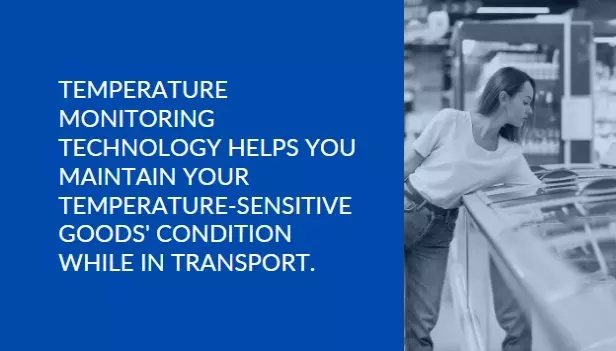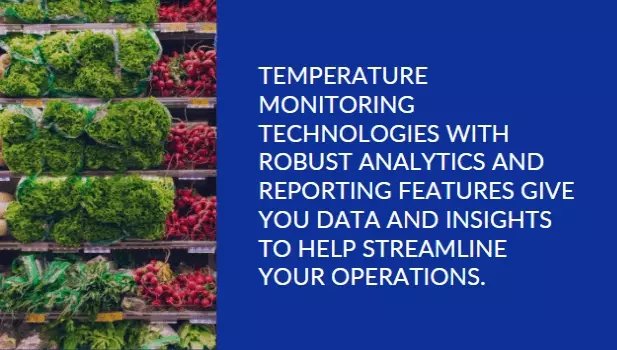Comments
- No comments found

Finding out too late that proper temperatures were not maintained somewhere along your supply chain can lead to massive product and revenue loss.
That is why seeing your products’ temperature conditions in real-time using the right technology is crucial, so you can act and intervene immediately (when possible) to minimize losses.
Through temperature monitoring technology, often using sensors which send information to the cloud, you get real-time data and better manage your cold chain to help maintain your perishable and temperature-sensitive products’ quality.
This guide covers the importance of temperature monitoring technology in managing your cold chain effectively.
Temperature monitoring technology are the devices and systems that help you track the particular environment’s temperature of your temperature-sensitive and perishable products.
Different industries, including hospitals, use the technology to preserve the condition of medicines, lab samples and other items. For example, many vaccines, including the newly released COVID-19 vaccines, require storage in sub-zero temperatures, requiring manufacturers, shipping partners and storage management companies to use dry ice temperature monitoring solutions, so as to avoid doses becoming ineffective.
Temperature monitoring systems allow you to track, and sometimes to even regulate and control your products’ temperature, ensuring that your merchandise stays safe and reaches its end users in pristine condition. Some of the most common temperature monitoring technologies include QR data loggers, external temperature probes and thermal buffers.
Below are some of the crucial roles temperature monitoring technology plays in cold chain management.
Temperature monitoring technologies help you retain the condition of your temperature-sensitive goods while being transported. These solutions tell you whether the environment these products are in are still cold enough to preserve them.
After all, temperatures can change drastically in different spots and times during transit. Temperature monitoring devices help oversee thermal readings when the weather gets hot upon leaving the garage or starts raining in the following hours.
They are also useful for when your truckers take their lunch breaks, as they can adjust and maintain temperatures accordingly and check if the thermal controlling system is functioning properly or not.

Temperature monitoring systems are also critical because, for some items, slight temperature changes can diminish or ruin their quality and render them unfit to be served. For example, vaccines, medicines, desserts, perishable foods, and other items need to be continuously stored in specific and low temperatures to be suitable for use or consumption.
Companies often employ dry ice temperature monitoring systems to ensure the maintenance of frozen temperatures.
These monitoring technologies have powerful sensors that constantly track temperatures in the environment and tally the values. They also gather, store, control, and digitize temperature data that their sensors receive and alert you when figures are beyond the acceptable range.
Temperature monitoring systems increase assurance of your quality and minimize temperature-related cargo rejections, expensive spoilage allegations, and redelivery costs. They can even help identify when shipments have been tampered with, if your system supports “lockdown mode” features.
Accurate thermal measurements are critical in cold chain management. Reading low temperatures when they are high does not prompt you to apply the right remedies, resulting in spoiled and unusable items. Such is the tendency when you manually assess them. However, when you use temperature monitoring devices, you can get accurate values and determine the proper courses of action.
Temperature monitoring technologies have powerful temperature probes (known as sensors) with specific measurement ranges suited to your business requirements, such as accuracy levels, stability, operational periods, and more. For instance, if you are transporting medications or refrigerated samples, you will need devices that can measure down to at least half a degree.
The heart of temperature monitoring solutions – the measurement component – connects to these sensors, digitizes the readings, and records or, in the case of network-based systems, transmits the data to a server.
With accurate recordings by temperature monitoring solutions, you can better regulate your cold chain management workflows, cool environments for your deliveries, and comply with industry standards.
Smart, modern temperature monitoring technologies have robust analytics and reporting features that provide you the necessary data and insights to streamline your operations. The Internet of Things (IoT) makes that possible.
Wireless temperature data loggers provide you with real-time, remote access to temperature data and more via Wi-Fi, cellular networks and other communication systems. Other logger solutions send information to central databases using connected radio signal hubs, USB jacks or tags that can be scanned using Bluetooth transmitters or QR codes.
Such devices can present graphs of data points gathered over a definite but adjustable period, such as the previous week or month, on any selected unit. They can continuously show the average, maximum, minimum, or mean kinetic temperature (MKT), record these data, and signify a temperature excursion with an LED light serving as external hints of temperature spikes.
These data presentation features remove the need to connect your temperature monitoring devices to computers or download the information to your handheld gadgets. Once the data syncs, in one glance, you can tell whether your cold chain cargo is damaged or not.

Additionally, temperature monitoring systems can produce several insightful reports and give you previews of the documents before exporting or printing them.
Data reporting, transfer, and sharing are also convenient. You can stream and access data from secure servers or integrate them into your enterprise software tools, such as transportation management system (TMS), warehouse management system (WMS), enterprise resource planning (ERP), etc.
If your temperature monitoring device allows integration of live cold chain data with cloud-based analytics and data storage solutions, you can maximize your big data for predictive analytics. This feature is common among enterprise-level temperature monitoring technologies. Predictive analytics helps you forecast, for example, which hotspots are likely to emerge in specific storage locations, how much coolant you will need for multimodal transport, and more.
Recording cold temperatures manually or on paper runs the risk of missing proper documentation schedules, writing down the wrong details, and other crucial actions. Temperature changes at specific times can also go out of your staff’s close observation as they attend to their other tasks.
On the other hand, temperature monitoring technologies have automation capabilities that always keep track of thermal readings accurately and on designated periods and intervals, such as every 30 or 60 minutes.
Customizable and user-friendly, these devices let you monitor and log a spectrum of information more quickly, such as humidity, pressure, temperature, and other relevant measures according to the installed sensors’ functionalities.
All these automation features enhance your operational efficiency, streamline your temperature monitoring tasks, and improve productivity.
Temperature monitoring technologies are critical in preserving your transported cold items.
Without these, your products' quality can suffer, making them unfit to be served to your clients or their customers, resulting in product waste and huge revenue and client relationship losses.
Invest in reliable temperature monitoring technologies to ensure your products are in excellent condition as they move through your cold chain.
Leave your comments
Post comment as a guest